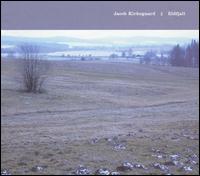 Sound artist and previous Philip Jeck collaborator, Kirkegaard presentsan album of geothermal recordings collected around geysers inIceland. Surprisingly, the results are a little flat: the record exists more likebank of archival documents, gravelly source material awaiting revamp.
Sound artist and previous Philip Jeck collaborator, Kirkegaard presentsan album of geothermal recordings collected around geysers inIceland. Surprisingly, the results are a little flat: the record exists more likebank of archival documents, gravelly source material awaiting revamp.Made entirely from accelerometer recordings, microphonesstuck in the Earth’s crust, this record has a few surprises at first. My initial problem was how one-dimensional itseemed. Familiar with similar soundartists like Rolf Julius, who manage to infuse environments of largelymonochromatic sounds and repetitious structures with real senses of immenseduration or even sacred ground, I was surprised to find Kirkegaard’s flat.
He has, no doubt, a knack for exhuming some potent texturesfrom the geysers and creases of Iceland: crazy pinging bubbles, likeball-bearings in miles of plate-grind, howling hollow noises in a crust dreamof the sky above, even a few downright mechanical clicking passages, the ones Ithink most able to exist as they do, without any noticeable or directivemanipulation. Problem is, nearly everytrack exists in the same way, the majority given no beginning or end dynamic, arrivingand retreating as simple pieces of tape, straight from the source, andromantically so, but listening suffers.
Abrupt cuts abound, making every piece feel like justanother unwieldy slab of abstract sound, aesthetically an all-over paintingwith nothing jumping out more than the whole. Saving grace: that in this case human gesture ends before sound begins, soa certain sense of awe, at the beauty or the absolute power of the landscape,is unavoidable. But the editing on thesetracks, never over eight minutes and often under three, feels always to belacking, in the jarring way that tracks begin and end with little regard forhow such potentially provocative recordings enter listening space, a problemcompounded by the fact that the unadorned nature of the sounds rarely promisesthe dynamics capable of filling such bracketed ear-time.
My aesthetic would have Eldfjallcondensed into a few much longer, more volatile, and better integrated trackswhere the quieter, dormant sounds would be allowed the full meditative drawlthey need, and the more active sounds given a more focused delivery. At appropriatevolumes and with an ear that can ignore the jarring breaks, there are timeswhen Kirkegaard’s straight-up approach feels a bit like a blessing in disguise. That recordings like these are even beingpassed around feels like progress to me, and I’ve had moments of realsubmersion within the seismic fragments herein. I even feel a sense of guilt being underwhelmed by a catalog of earthencrust noise, but it’s one I can’t shake.
samples:
Read More

